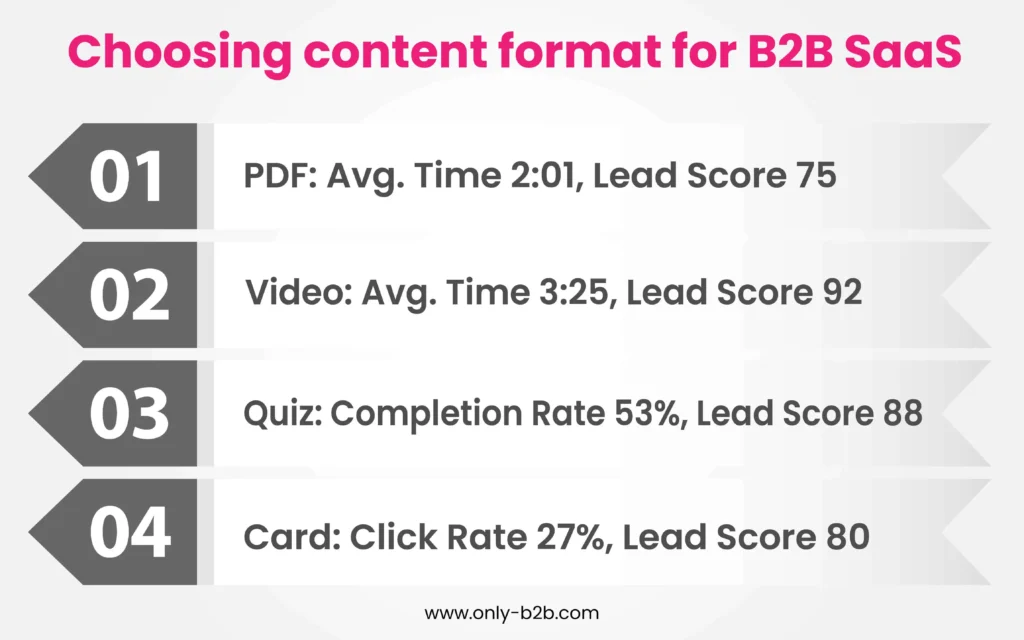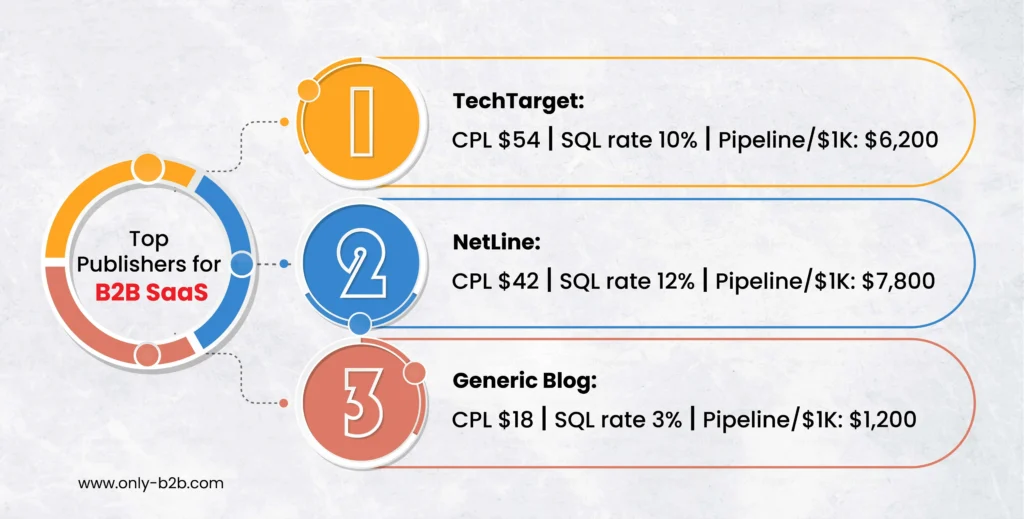82% of B2B marketers say content marketing is foundational, and 48% are shifting budgets specifically toward distribution and syndication (Demandview).
That’s encouraging, but there’s a concern we should look into. Everyone is doing it. Means the competition is fierce. Even a small mistake in choosing your vendor, target, or content can quickly waste your efforts.
If you’re a marketer, demand gen executive, or anybody who is breathing pipeline goals, this guide is for you.
At the end of it, you will know how you can make your syndication efforts an ROI generator, not a budget drain.
The Real Pain: “Good Enough” Leads That Waste Time
Table of Contents
- 1 The Real Pain: “Good Enough” Leads That Waste Time
- 1.1 7 Advanced Syndication Strategies You Probably Aren’t Using
- 2 Final Thoughts
Who doesn’t like to see a funnel full of leads? But if it’s bloated with the wrong ones, it’s better not to have it filled at all.
The results are disastrous.
- Your CRM becomes cluttered.
- SDRs waste time chasing unqualified prospects.
- Trust between marketing and sales begins to erode.
The belief that low CPL equals success is deeply ingrained. In truth, a $20 lead that never engages costs more in hidden waste than a $60 lead that actually converts.
In fact, syndication leads convert at an average of 5.31%, nearly double the general B2B average of ~2.23% (Demandview). So, if you’re falling short, the issue isn’t the channel. It’s your process.
Another overlooked problem is duplicate content and SEO cannibalization. If your syndicated version outranks your original asset or blog post, you lose organic traffic and authority.
You can easily fix this with canonical tags, “no-index” directives, and unique summaries for each syndicated piece (ContentSyndication.org).
The real issue isn’t lack of reach. It’s operational inefficiency hidden behind surface-level success metrics.
7 Advanced Syndication Strategies You Probably Aren’t Using
1. Multi-Vendor Approach
Is ease and habit making you stick to one vendor? Have you ever tried A/B testing? Too many marketers pick one and scale blindly.
But betting on a single pipeline source could be the reason for diminishing returns. You should run vendor arbitration instead.
How does it work?
- Run small pilots with two or three premium vendors.
- Shift your budget toward the one delivering the best pipeline yield, not just lead volume.
- Use dashboards that track MQL-to-SQL velocity to identify top performers.
The golden metric here isn’t lead volume. It’s pipeline influenced per dollar.
2. Create Micro-Variant Content
Creating one asset and blasting it across all platforms is what average marketers do. Top performers, on the other hand, use micro-variants, which are different formats of the same content, each optimized for context and consumption habits.

Do vendors support creative testing? Absolutely. Modern syndication vendors are adding AI-driven creative optimization that tests which format resonates best by persona, industry, or device.
For example, two engineers might see the same report but presented differently—one as a downloadable PDF and another as an interactive visual summary.
This kind of personalization not only boosts CTR but also improves time-on-content and downstream conversions.
3. Leveraging Intent Data
They say, “Don’t treat all signals differently.” But elite teams know how to do it.
They break intent intensity into thresholds. They handle each lead based on their signal strength:
- Leads with 1–2 signals stay in nurture
- Leads with 3–5 signals move to SDR review
- Leads with 6 or more signals or demo-page hits go straight to sales
This approach ensures your SDRs only chase prospects with validated buying intent, those who have shown consistent engagement across multiple intent categories.
The shift is simple and urgent: qualify how deeply a lead is researching, not just what they’re researching.
By combining intent intensity with firmographic fit, SaaS marketers are reporting 30–40% higher SQL conversion rates without increasing total lead volume.
4. Skipping “Lead Stage 0”
Most marketers are still stuck in the outdated syndication model: download → nurture → sales outreach. Sure, it’s safe, but it’s too slow. Many leads stall before any meaningful engagement.
Instead, introduce “Lead Stage 0” interactions, which are micro-engagements that happen immediately after a content download while the user’s attention is still fresh.
Example:
Right after someone clicks “Download,” trigger a one-question micro-survey such as:
“Which of these is your biggest challenge right now?”
The response feeds straight into your CRM, adding instant context.
Doing this allows your system to auto-route or prioritize the lead. You turn a generic contact into an enriched, pre-qualified opportunity before your SDRs ever reach out.
The best part is that you qualify leads within the syndication window. It’s an easy, low-friction way to accelerate conversion.
5. Reputation-Based Syndication Whitelisting
Not every publisher is worth your budget. Yet many marketers distribute content through all available channels, even those that deliver mediocre traffic.
The fix is to create a reputation-based publisher whitelist, a shortlist of domains that have historically driven high CTR to SQL conversion rates for your brand.
Steps to build one:
- Analyze historical syndication data across vendors.
- Identify 5–10 publisher sites where your conversion rates outperform the mean.
- Label them “premium channels.”
- Route high-value or late-stage content exclusively through these domains, even if their CPL is higher.
The ROI logic is simple. A $100 CPL from a trusted publisher that converts four times better beats a $40 lead that never closes.

Over time, this creates a brand-safe syndication ecosystem built on concentrated quality instead of diluted quantity.
6. Attribution Stitching and Reverse Lead Match
Here’s one of the most persistent syndication blind spots. Once a lead enters your system, attribution often vanishes.
A user downloads your gated asset, disappears for weeks, then returns via a brand search and converts. Without proper tracking, the conversion gets credited to “organic” or “direct,” not to syndication where it started.
Here comes into the picture: attribution stitching. What is it? It’s a combination of reverse lead match and content fingerprinting that reconnects those dots. Each asset is assigned a unique fingerprint.
In short: it “stitches” together the hidden or disconnected signals so you can see which campaigns actually influenced a sale.
So when a known lead revisits your site, the system recognizes the fingerprint match and attributes the eventual conversion back to the original syndication source.
Why this matters:
- It reveals the true ROI of syndication efforts
- It helps justify spend to leadership
- It uncovers which assets quietly influence later-stage deals
Vendors like Integrate and TechTarget already offer match-back analytics as part of their premium packages, making this tactic more accessible than ever.
7. Syndication with Product Data Triggers
The next evolution of syndication is contextual matching, using product or technographic data to personalize which content gets syndicated to whom.
If you know a prospect’s tech stack, tools, or platform preferences, you can syndicate exactly the right asset to match that context.
For example:
- A lead running Kubernetes workloads sees your “Kubernetes Performance Benchmark.”
- A company researching CI/CD automation gets your “Cost Optimization for DevOps Pipelines” guide.
This level of alignment makes the experience feel consultative, not promotional. Because the content is instantly relevant, click-to-conversion rates rise dramatically.
Dynamic syndication based on inferred product signals is still rare, but early adopters report 25–30% faster funnel progression from first touch to SQL.
Final Thoughts
You’ve made it this far, and we’re sure you no longer see content syndication as a plug-and-play channel.
To make it truly ROI-driven, you must move beyond volume metrics and build a feedback loop of quality, intent, and attribution.
The best SaaS demand generation teams won’t just distribute content. They’ll engineer syndication ecosystems that learn, adapt, and outperform.
Before your next campaign, ask yourself:
Are you syndicating content, or are you syndicating insight?
That answer will determine whether your program becomes a pipeline multiplier or a budget sink.

Vikas Bhatt is the Co-Founder of ONLY B2B, a premium B2B lead generation company that specializes in helping businesses achieve their growth objectives through targeted marketing & sales campaigns. With 10+ years of experience in the industry, Vikas has a deep understanding of the challenges faced by businesses today and has developed a unique approach to lead generation that has helped clients across a range of industries around the globe. As a thought leader in the B2B marketing community, ONLY B2B specializes in demand generation, content syndication, database services and more.





